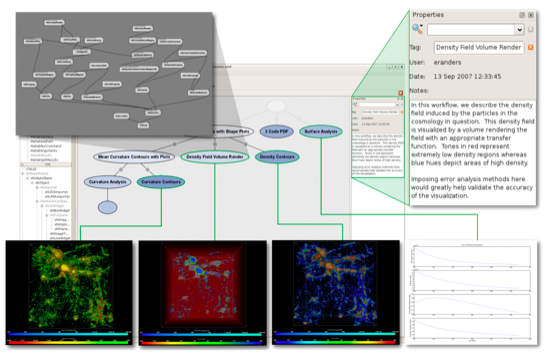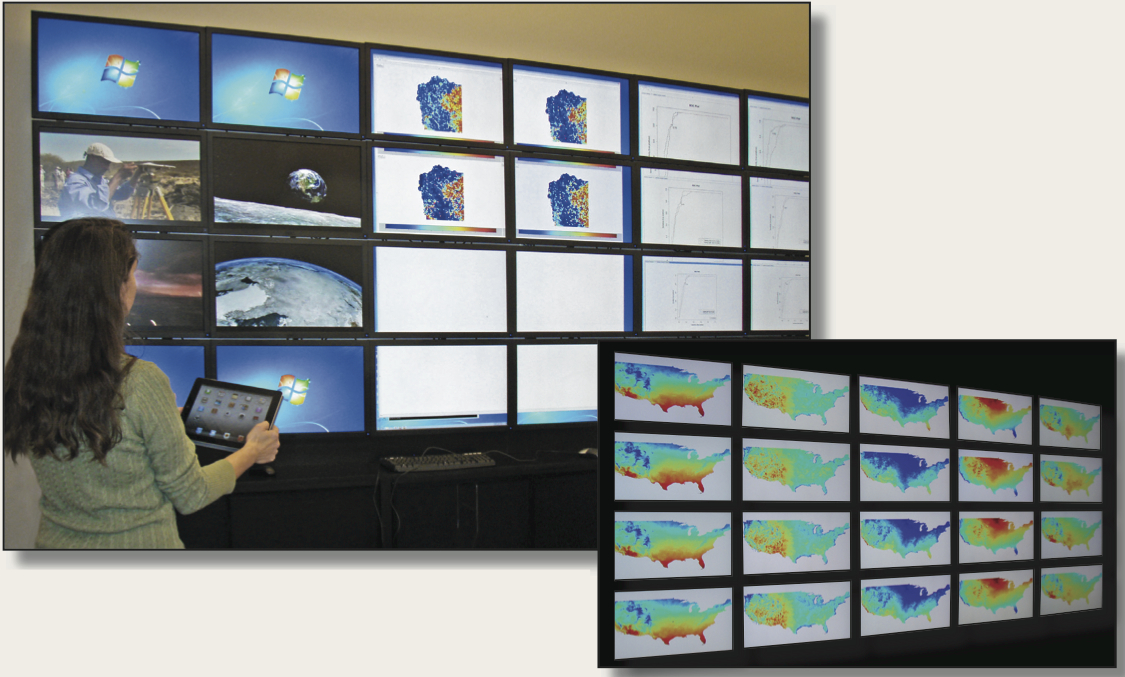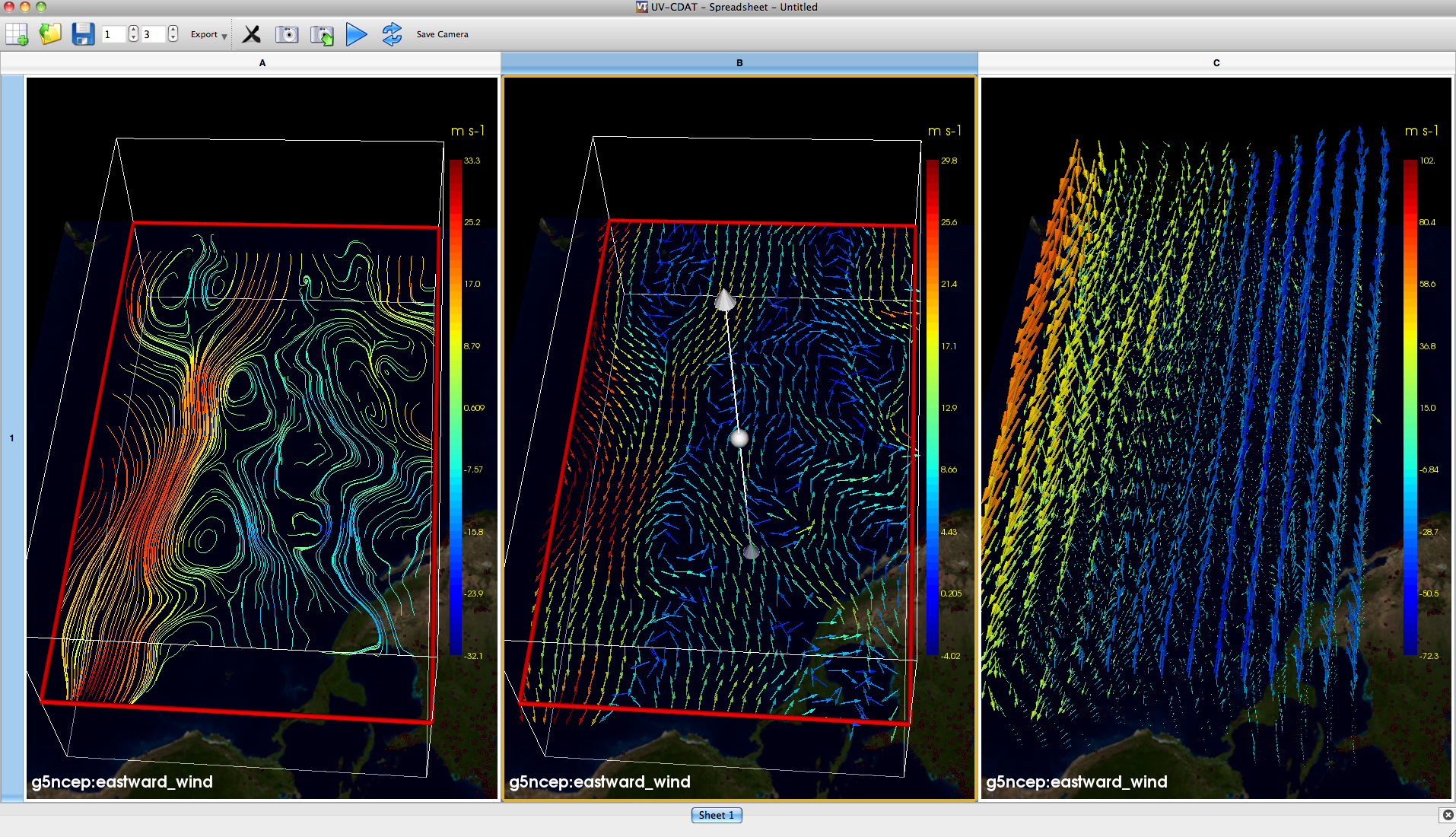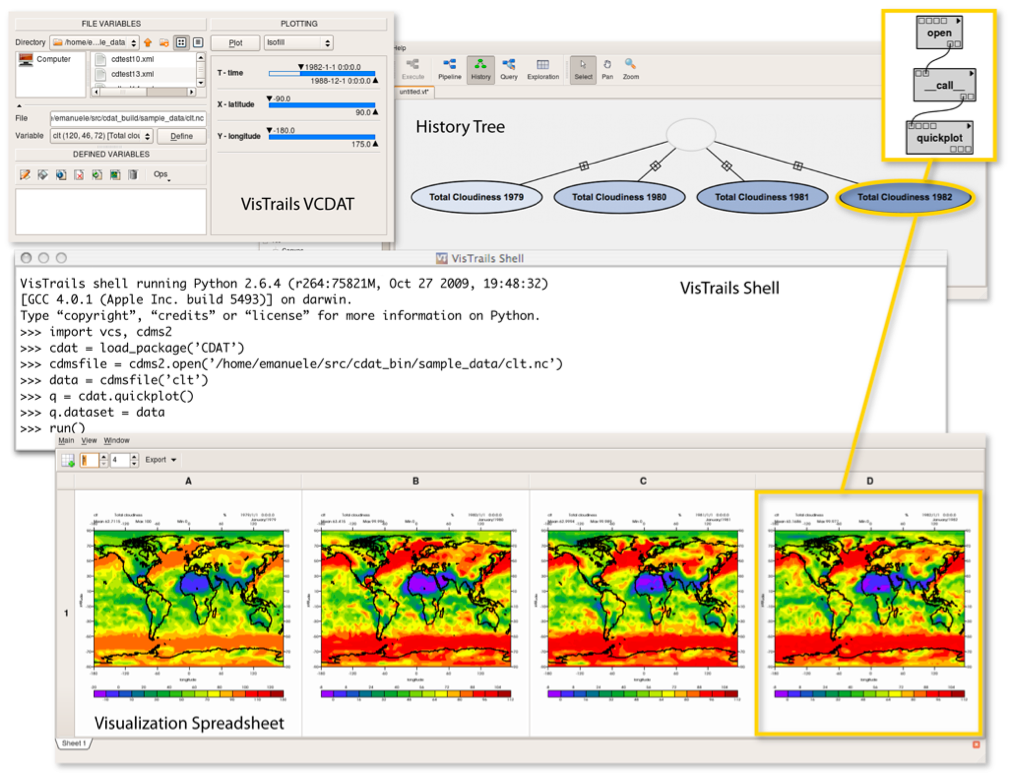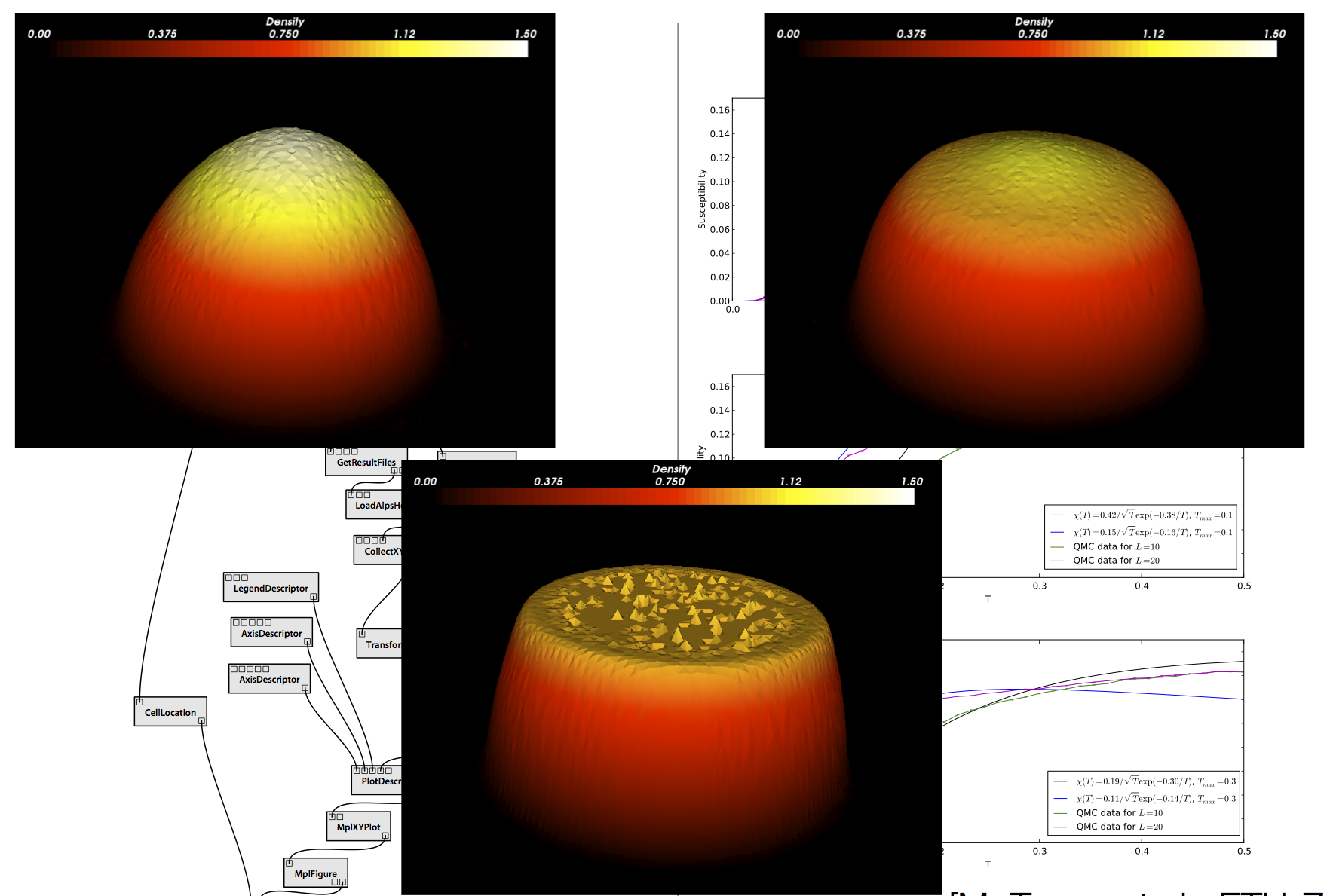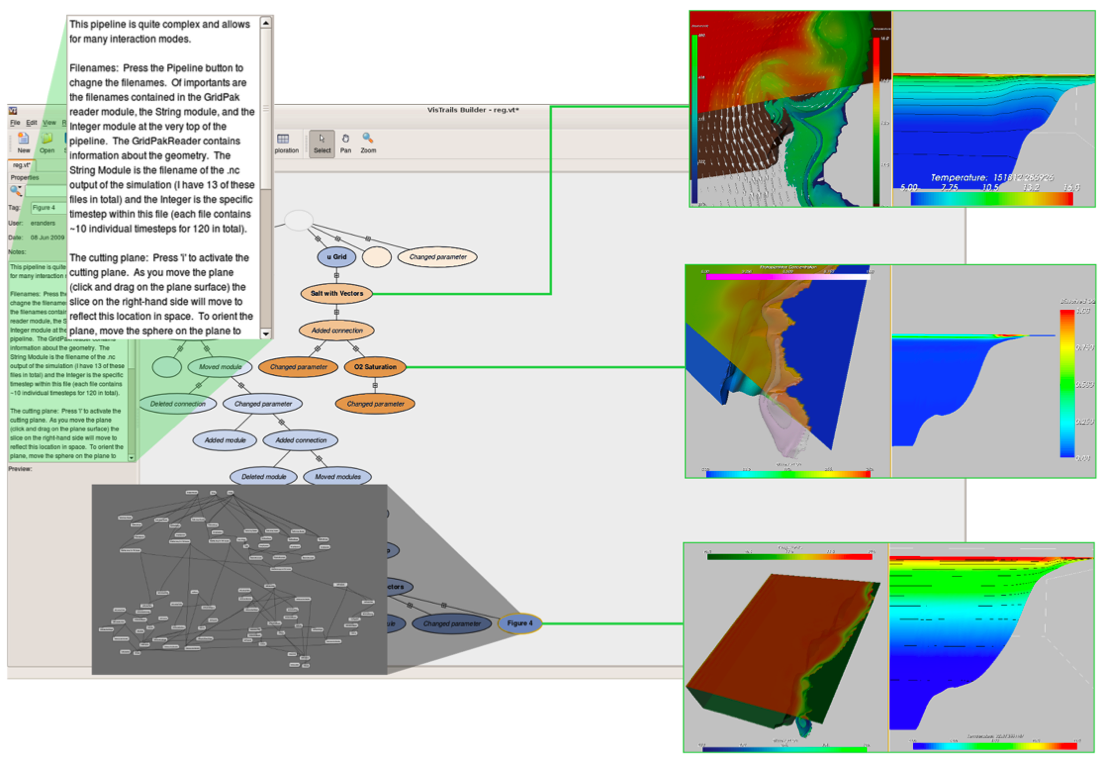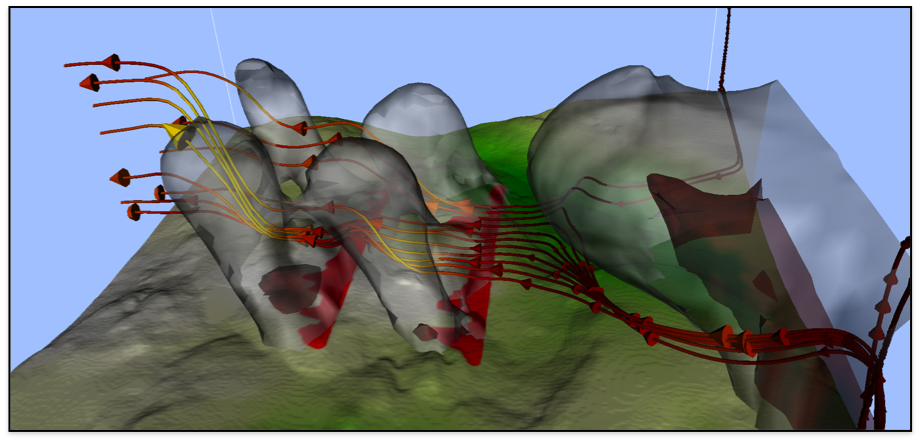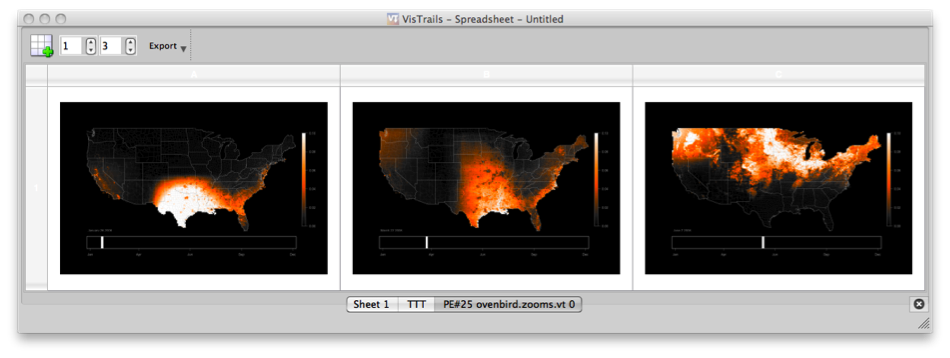Difference between revisions of "Main Page"
| (176 intermediate revisions by 15 users not shown) | |||
| Line 1: | Line 1: | ||
This is the official website for VisTrails, an open-source scientific workflow and provenance management system that supports data exploration and visualization. | |||
VisTrails provides a general infrastructure that can be combined with existing systems and libraries. Official releases come with several packages, including VTK, matplotlib, and ImageMagick. The system is written in Python/Qt and runs on Mac, Unix and Windows. | |||
[[#Downloading VisTrails|Read more >]] | |||
VisTrails | |||
'''Please note that as of 2018, we are no longer maintaining VisTrails.''' | |||
== Downloading VisTrails == | |||
Current and past releases are available on our [[downloads|download page]]. | |||
== | == News == | ||
* Unfortunately we can no longer maintain VisTrails | |||
* [2016-05-03] VisTrails 2.2.4 has been released and is available on the [[Downloads]] page. | |||
* [2015-09-11] SAHM VisTrails training course at USGS: http://pubs.usgs.gov/fs/2014/3007/pdf/fs2014-3007.pdf | |||
* [2015-07-10] VisTrails 2.2.2 has been released and is available on the [[Downloads]] page. | |||
* [2015-04-22] VisTrails 2.2 has been released and is available on the [[Downloads]] page. | |||
* [2015-03-21] VisTrails 2.1.5 has been released and is available on the [[Downloads]] page. | |||
* [2014-08-25] VisTrails 2.1.4 has been released and is available on the [[Downloads]] page. | |||
* VisTrails 2.0.3 has been released and is available on the [[Downloads]] page. | |||
* To learn more about how to explore climate data using DV3D and ParaView in UV-CDAT, check out http://www.kitware.com/source/home/post/105 | |||
* Comparison of two forecasts of Hurricane Sandy using the DV3D slicer in UV-CDAT http://www.youtube.com/watch?v=BFN0RzN1hSE&feature=em-share_video_user | |||
* Presentation on the use of VisTrails at NASA: VisTrails: Workflow Management System on NEX - https://c3.nasa.gov/nex/static/media/other/Vistrails-Votava.pdf | |||
* VisTrails 2.0 has been released and it is available for download on our [[Downloads]] page. VisTrails is now distributed under the BSD license and its GUI was completely re-designed to make it easier to manage and interact with multiple workflows. It also includes a much improved [https://vistrails.org/usersguide Users' Manual]. See the [http://sourceforge.net/projects/vistrails/files/vistrails/v2.0/README/view release notes] for a complete list of changes. Some notable features include: | |||
** the ability to create mashups; | |||
** support for the creation of reproducible papers; | |||
** a provenance viewer; | |||
** support for visual diffs as well as queries over workflows in different vistrails; | |||
** a Control Flow Assistant to simplify the creation of workflows with loops and conditional constructs; | |||
** support for global variables, so that modules deriving from Constant can be used to create variables that are shared among multiple workflows. | |||
[http:// | [[Image:Screen Shot 2012-01-12 at 2.50.19 PM.png|200px|right]] | ||
* UV-CDAT 1.0.0 has been released. More detailed information and binaries are available at http://uvcdat.llnl.gov | |||
** UV-CDAT was demoed at [http://ipaw2012.bren.ucsb.edu IPAW 2012] | |||
** Video tutorials are available at http://uv-cdat.llnl.gov/wiki/VideoTutorials | |||
** Binaries (Mac/RedHAT6/Ubuntu) or build-from-sources options can be found here: http://uv-cdat.llnl.gov/install/ | |||
** Please report any issues you encounter via bugzilla at: http://uv-cdat.llnl.gov/bugzilla/ | |||
[ | * [[Older News]] | ||
[ | == VisTrails Overview == | ||
[[Image:Cosmology_example.png|480px|right]] | |||
VisTrails is an open-source scientific workflow and provenance management system that provides support for simulations, data exploration and visualization. Whereas workflows have been traditionally used to automate repetitive tasks, for applications that are exploratory in nature, such as simulations, data analysis and visualization, very little is repeated---change is the norm. As an engineer or scientist generates and evaluates hypotheses about data under study, a series of different, albeit related, workflows are created while a workflow is adjusted in an interactive process. VisTrails was designed to manage these rapidly-evolving workflows. | |||
A key distinguishing feature of VisTrails is a comprehensive provenance infrastructure that maintains detailed history information about the steps followed and data derived in the course of an exploratory task: VisTrails maintains provenance of data products, of the workflows that derive these products and their executions. This information is persisted as XML files or in a relational database, and it allows users to navigate workflow versions in an intuitive way, to undo changes but not lose any results, to visually compare different workflows and their results, and to examine the actions that led to a result. It also enables a series operations and user interfaces that simplify workflow design and use, including the ability to create and refine workflows by analogy and to query workflows by example. | |||
[http://www. | VisTrails supports the creation and execution of workflows. It allows the combination of loosely-coupled resources, specialized libraries, grid and Web services. The released version comes with support for several packages including, [http://www.vtk.org/ VTK], [http://www.imagemagick.org/script/index.php Image Magick], Web Services, and [http://www.scipy.org/PyLab pylab]. You can also download [[UserContributedPackages|packages contributed by our users]], as well as [http://vistrails.org/usersguide/v2.1/html/packages.html create your own packages/modules]. There are also a number of [[Projects using VisTrails|projects extending or building on top of VisTrails]]. | ||
Workflows can be run interactively, through the VisTrails GUI, or in batch using a VisTrails server. | |||
VisTrails 1.0 was released in October 2007. Since then, the system has been downloaded thousands of times. VisTrails is written in Python and it uses the multi-platform Qt library for its user interface. It runs on Mac, Linux and Windows. You can download VisTrails from https://vistrails.org/index.php/Downloads | |||
=== Publishing Reproducible Results === | |||
VisTrails 2.0 allows the inclusion of reproducible results in LaTeX/PDF documents. We provide a LaTeX package that allows users to add links to their results in the LaTeX source. For example: | |||
<code> | |||
\usepackage{vistrails} | |||
... | |||
\begin{figure} | |||
\begin{center} | |||
{ | |||
\subfigure[a=0.9]{\vistrail[filename=alps.vt, version=2, pdf]{width=8cm}} | |||
{ | |||
{ | |||
\subfigure[a=0.9]{\vistrail[filename=alps.vt, version=11, pdf,buildalways]{width=8cm}} | |||
\caption{A figure produced by an ALPS VisTrails workflow. Clicking the figure retrieves the workflow used to | |||
create it. Opening that workflow on a machine with VisTrails and ALPS installed lets the reader execute the full calculation.} | |||
\end{center} | |||
\end{figure} | |||
</code> | |||
Once the LaTeX document is compiled, the figure in the PDF becomes active, and when clicked, it will invoke VisTrails and reproduce the result. | |||
You can also upload your results to [http://www.crowdlabs.org CrowdLabs] and export them to Web sites or Wikis, where users can interact with them through a Web browser. See e.g., http://www.crowdlabs.org/vistrails/medleys/details/26/ | |||
=== Building Workflows === | |||
VisTrails supports workflows expressed as dataflows. It can also support functional loops and conditional statements (new in VisTrails 1.3!). In addition, VisTrails is easily extensible; users can quickly create new modules or wrap existing code or libraries for use as modules in VisTrails. Also, the <code>PythonSource</code> module can be used to write one-time translations or test code in a workflow. See the [http://sourceforge.net/projects/vistrails/files/vistrails/vistrails-usersguide-1.3-rev198.pdf/download Users' Guide] for more details on all of these features. | |||
=== Combining VisTrails Provenance with other Tools === | |||
[[Image:DisplayWall_ipod_screenshot.png|180px|right]] | |||
The VisTrails provenance infrastructure can also be combined with interactive tools. We are developing a series of provenance plugins for different tools, including [https://wci.llnl.gov/codes/visit VisIt] and [http://www.paraview.org/ ParaView]. The [https://vistrails.org/index.php/ParaView_Plugin open-source ParaView plugin has been released]. | |||
=== Visualizing and Comparing Workflow Results === | |||
VisTrails provides a ''spreadsheet'' where users can compare the results of multiple workflows, or multiple workflow runs. Besides using a desktop, you can display the results of VisTrails workflows on a display wall or on an iPod. Users can also compare different workflows using the visual difference interface. | |||
== | === Querying and Refining Workflows by Example === | ||
Users can quickly construct expressive queries over a collection of workflows by example, using the same familiar interface they use to build workflows. VisTrails also provides an analogy mechanism whereby users can perform complex modifications to workflows by analogy, without having to directly modify the workflow specifications. | |||
== | ==[[Documentation|System Documentation]]== | ||
If you want to get more information about VisTrails you can consult the Users' Manual or the FAQ (see links below). If you have questions that are not answered in these resources, you can post it to the users' mailing list: https://vistrails.org/index.php/MailingLists | |||
To report bugs, please use our bug tracker: https://github.com/VisTrails/VisTrails/issues | |||
=== | === [[Documentation#Screen Shots|Screen Shots]]=== | ||
=== [[Users_Guide|User's Guide]]=== | |||
A Web version of the Users Guide is currently under development and can be accessed at https://vistrails.org/usersguide. | |||
=== [[FAQ]]=== | |||
==[[MailingLists|Mailing Lists]]== | |||
==[[Publications, Tutorials and Presentations]]== | |||
==[[People]]== | |||
== | == [https://vistrails.org/index.php/Projects_using_VisTrails Some Projects using VisTrails] == | ||
{| class="wikitable" | |||
|- | |||
! USGS Habitat modeling | |||
|- | |||
| [[Image:usgs.png|200px|left]] | |||
| | |||
|} | |||
{| class="wikitable" | |||
|- | |||
! NASA Climate Data Analysis | |||
! DOE CDAT | |||
! ALPS Simulations | |||
|- | |||
| [[Image:nasa.png|200px|left]] | |||
| [[Image:cdat.png|200px|left]] | |||
| [[Image:alps-shot.png|200px|left]] | |||
| | |||
|} | |||
{| class="wikitable" | |||
|- | |||
! NSF STC CMOP | |||
! NSF CDI Wildfire | |||
! NSF DataONE-EVA | |||
|- | |||
| [[Image:cmop-ss.png|200px|left]] | |||
| [[Image:wildfire.png|200px|center]] | |||
| [[Image:eva.png|200px|left]] | |||
| | |||
|} | |||
[https://vistrails.org/index.php/Projects_using_VisTrails See other projects] | |||
== [[Vistrails and Teaching]] == | |||
The VisTrails system has been used a tool to teach different courses, including Scientific Visualization and Digital Media. | |||
For more information on the educational uses of VisTrails see [http://vistrails.org/index.php/Vistrails_and_Teaching VisTrails and Teaching]. Our [http://www.cs.utah.edu/~juliana/pub/vistrails-teaching-eurographics2010.pdf paper] describing a provenance-rich teaching methodology received the Best Paper Award at the Eurographics 2010 Education program. | |||
== Sponsors == | == Sponsors == | ||
This work has been partially supported by the National Science Foundation under grants | This work has been partially supported by the National Science Foundation under grants | ||
[http://www.nsf.gov/awardsearch/showAward.do?AwardNumber=0905385 IIS-0905385], | |||
[http://www.nsf.gov/awardsearch/showAward.do?AwardNumber=0844572 IIS-0844572], | |||
[http://www.nsf.gov/awardsearch/showAward.do?AwardNumber=0746500 IIS CAREER-0746500], | |||
[http://www.nsf.gov/awardsearch/showAward.do?AwardNumber=0751152 CNS-0751152], | |||
[http://www.nsf.gov/awardsearch/showAward.do?AwardNumber=0513692 IIS-0513692], | [http://www.nsf.gov/awardsearch/showAward.do?AwardNumber=0513692 IIS-0513692], | ||
[http://www.nsf.gov/awardsearch/showAward.do?AwardNumber=0401498 CCF-0401498], | [http://www.nsf.gov/awardsearch/showAward.do?AwardNumber=0401498 CCF-0401498], | ||
[http://www.nsf.gov/awardsearch/showAward.do?AwardNumber=0541560 CNS-0541560], [http://www.nsf.gov/awardsearch/showAward.do?AwardNumber=0405402 OISE-0405402], | [http://www.nsf.gov/awardsearch/showAward.do?AwardNumber=0541560 CNS-0541560], [http://www.nsf.gov/awardsearch/showAward.do?AwardNumber=0405402 OISE-0405402], | ||
[http://www.nsf.gov/awardsearch/showAward.do?AwardNumber=0424602 OCE-0424602], | [http://www.nsf.gov/awardsearch/showAward.do?AwardNumber=0424602 OCE-0424602], | ||
[http://www.nsf.gov/awardsearch/showAward.do?AwardNumber=0524096 CNS-0524096], | |||
[http://www.nsf.gov/awardsearch/showAward.do?AwardNumber=0534628 IIS-0534628], | |||
the Department of Energy under the SciDAC program | the Department of Energy under the SciDAC program | ||
([http://www.scidac.org/compsci/SDM.html SDM] | ([http://www.scidac.org/compsci/SDM.html SDM] | ||
and | and | ||
[http://www.scidac.org/viz/VACET.html VACET]), | [http://www.scidac.org/viz/VACET.html VACET]) and UV-CDAT, | ||
IBM Faculty Awards (2005 and | IBM Faculty Awards (2005, 2006, 2007, and 2008) and a University of Utah Seed Grant. | ||
== Related Sites == | |||
[[BirdVis]] | |||
[http://www.crowdlabs.org CrowdLabs] | |||
[[RepeatabilityCentral]] | |||
[[ProvenanceAnalytics]] | |||
[[Provenance: potpourri]] | |||
Latest revision as of 17:30, 25 April 2022
This is the official website for VisTrails, an open-source scientific workflow and provenance management system that supports data exploration and visualization.
VisTrails provides a general infrastructure that can be combined with existing systems and libraries. Official releases come with several packages, including VTK, matplotlib, and ImageMagick. The system is written in Python/Qt and runs on Mac, Unix and Windows.
Please note that as of 2018, we are no longer maintaining VisTrails.
Downloading VisTrails
Current and past releases are available on our download page.
News
- Unfortunately we can no longer maintain VisTrails
- [2016-05-03] VisTrails 2.2.4 has been released and is available on the Downloads page.
- [2015-09-11] SAHM VisTrails training course at USGS: http://pubs.usgs.gov/fs/2014/3007/pdf/fs2014-3007.pdf
- [2015-07-10] VisTrails 2.2.2 has been released and is available on the Downloads page.
- [2015-04-22] VisTrails 2.2 has been released and is available on the Downloads page.
- [2015-03-21] VisTrails 2.1.5 has been released and is available on the Downloads page.
- [2014-08-25] VisTrails 2.1.4 has been released and is available on the Downloads page.
- VisTrails 2.0.3 has been released and is available on the Downloads page.
- To learn more about how to explore climate data using DV3D and ParaView in UV-CDAT, check out http://www.kitware.com/source/home/post/105
- Comparison of two forecasts of Hurricane Sandy using the DV3D slicer in UV-CDAT http://www.youtube.com/watch?v=BFN0RzN1hSE&feature=em-share_video_user
- Presentation on the use of VisTrails at NASA: VisTrails: Workflow Management System on NEX - https://c3.nasa.gov/nex/static/media/other/Vistrails-Votava.pdf
- VisTrails 2.0 has been released and it is available for download on our Downloads page. VisTrails is now distributed under the BSD license and its GUI was completely re-designed to make it easier to manage and interact with multiple workflows. It also includes a much improved Users' Manual. See the release notes for a complete list of changes. Some notable features include:
- the ability to create mashups;
- support for the creation of reproducible papers;
- a provenance viewer;
- support for visual diffs as well as queries over workflows in different vistrails;
- a Control Flow Assistant to simplify the creation of workflows with loops and conditional constructs;
- support for global variables, so that modules deriving from Constant can be used to create variables that are shared among multiple workflows.
- UV-CDAT 1.0.0 has been released. More detailed information and binaries are available at http://uvcdat.llnl.gov
- UV-CDAT was demoed at IPAW 2012
- Video tutorials are available at http://uv-cdat.llnl.gov/wiki/VideoTutorials
- Binaries (Mac/RedHAT6/Ubuntu) or build-from-sources options can be found here: http://uv-cdat.llnl.gov/install/
- Please report any issues you encounter via bugzilla at: http://uv-cdat.llnl.gov/bugzilla/
VisTrails Overview
VisTrails is an open-source scientific workflow and provenance management system that provides support for simulations, data exploration and visualization. Whereas workflows have been traditionally used to automate repetitive tasks, for applications that are exploratory in nature, such as simulations, data analysis and visualization, very little is repeated---change is the norm. As an engineer or scientist generates and evaluates hypotheses about data under study, a series of different, albeit related, workflows are created while a workflow is adjusted in an interactive process. VisTrails was designed to manage these rapidly-evolving workflows.
A key distinguishing feature of VisTrails is a comprehensive provenance infrastructure that maintains detailed history information about the steps followed and data derived in the course of an exploratory task: VisTrails maintains provenance of data products, of the workflows that derive these products and their executions. This information is persisted as XML files or in a relational database, and it allows users to navigate workflow versions in an intuitive way, to undo changes but not lose any results, to visually compare different workflows and their results, and to examine the actions that led to a result. It also enables a series operations and user interfaces that simplify workflow design and use, including the ability to create and refine workflows by analogy and to query workflows by example.
VisTrails supports the creation and execution of workflows. It allows the combination of loosely-coupled resources, specialized libraries, grid and Web services. The released version comes with support for several packages including, VTK, Image Magick, Web Services, and pylab. You can also download packages contributed by our users, as well as create your own packages/modules. There are also a number of projects extending or building on top of VisTrails. Workflows can be run interactively, through the VisTrails GUI, or in batch using a VisTrails server.
VisTrails 1.0 was released in October 2007. Since then, the system has been downloaded thousands of times. VisTrails is written in Python and it uses the multi-platform Qt library for its user interface. It runs on Mac, Linux and Windows. You can download VisTrails from https://vistrails.org/index.php/Downloads
Publishing Reproducible Results
VisTrails 2.0 allows the inclusion of reproducible results in LaTeX/PDF documents. We provide a LaTeX package that allows users to add links to their results in the LaTeX source. For example:
\usepackage{vistrails}
...
\begin{figure}
\begin{center}
\subfigure[a=0.9]{\vistrail[filename=alps.vt, version=2, pdf]{width=8cm}}
\subfigure[a=0.9]{\vistrail[filename=alps.vt, version=11, pdf,buildalways]{width=8cm}}
\caption{A figure produced by an ALPS VisTrails workflow. Clicking the figure retrieves the workflow used to
create it. Opening that workflow on a machine with VisTrails and ALPS installed lets the reader execute the full calculation.}
\end{center}
\end{figure}
Once the LaTeX document is compiled, the figure in the PDF becomes active, and when clicked, it will invoke VisTrails and reproduce the result. You can also upload your results to CrowdLabs and export them to Web sites or Wikis, where users can interact with them through a Web browser. See e.g., http://www.crowdlabs.org/vistrails/medleys/details/26/
Building Workflows
VisTrails supports workflows expressed as dataflows. It can also support functional loops and conditional statements (new in VisTrails 1.3!). In addition, VisTrails is easily extensible; users can quickly create new modules or wrap existing code or libraries for use as modules in VisTrails. Also, the PythonSource module can be used to write one-time translations or test code in a workflow. See the Users' Guide for more details on all of these features.
Combining VisTrails Provenance with other Tools
The VisTrails provenance infrastructure can also be combined with interactive tools. We are developing a series of provenance plugins for different tools, including VisIt and ParaView. The open-source ParaView plugin has been released.
Visualizing and Comparing Workflow Results
VisTrails provides a spreadsheet where users can compare the results of multiple workflows, or multiple workflow runs. Besides using a desktop, you can display the results of VisTrails workflows on a display wall or on an iPod. Users can also compare different workflows using the visual difference interface.
Querying and Refining Workflows by Example
Users can quickly construct expressive queries over a collection of workflows by example, using the same familiar interface they use to build workflows. VisTrails also provides an analogy mechanism whereby users can perform complex modifications to workflows by analogy, without having to directly modify the workflow specifications.
System Documentation
If you want to get more information about VisTrails you can consult the Users' Manual or the FAQ (see links below). If you have questions that are not answered in these resources, you can post it to the users' mailing list: https://vistrails.org/index.php/MailingLists
To report bugs, please use our bug tracker: https://github.com/VisTrails/VisTrails/issues
Screen Shots
User's Guide
A Web version of the Users Guide is currently under development and can be accessed at https://vistrails.org/usersguide.
FAQ
Mailing Lists
Publications, Tutorials and Presentations
People
Some Projects using VisTrails
| USGS Habitat modeling | |
|---|---|
| NASA Climate Data Analysis | DOE CDAT | ALPS Simulations | |
|---|---|---|---|
| NSF STC CMOP | NSF CDI Wildfire | NSF DataONE-EVA | |
|---|---|---|---|
Vistrails and Teaching
The VisTrails system has been used a tool to teach different courses, including Scientific Visualization and Digital Media. For more information on the educational uses of VisTrails see VisTrails and Teaching. Our paper describing a provenance-rich teaching methodology received the Best Paper Award at the Eurographics 2010 Education program.
Sponsors
This work has been partially supported by the National Science Foundation under grants IIS-0905385, IIS-0844572, IIS CAREER-0746500, CNS-0751152, IIS-0513692, CCF-0401498, CNS-0541560, OISE-0405402, OCE-0424602, CNS-0524096, IIS-0534628, the Department of Energy under the SciDAC program (SDM and VACET) and UV-CDAT, IBM Faculty Awards (2005, 2006, 2007, and 2008) and a University of Utah Seed Grant.

